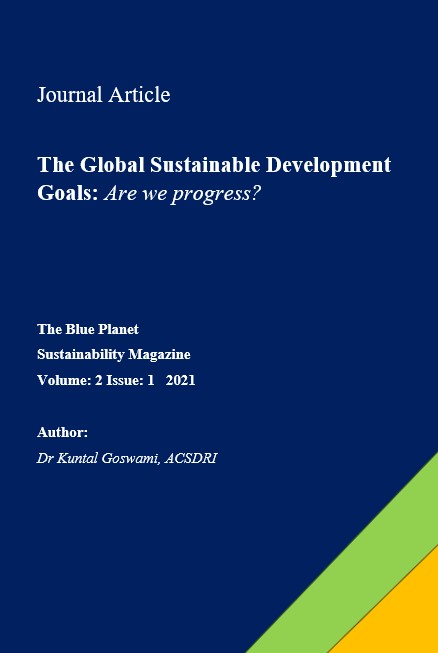Magazine Online
The Global Sustainable Development Goals: Are we progressing?
This brief empirical status report has compared 2016 and 2020 data sets of the global Sustainable Development Goals (SDGs) to understand the global progress on the Sustainable Development Goals.
In 2015, all member states of United Nations adopted the global Sustainable Development Goals (SDGs). In contrast with the Millennium Development Goals (MDGs), which were developing countries centric and had 60 indicators, SDGs are universal and addresses issues for both developed and developing countries.
The SDGs are all encompassing with 17 goals and 169 associated targets addressing global objectives for economic development, along with social, and environmental sustainability.
In comparison with the 2016 global SDG ranking index, only 33% of all countries were able to improve their respective SDG ranking in 2020; 6% of all countries were able to maintain their status quo; while61% of all countries declined in their overall SDG ranking.
In the category of “Countries Improved in SDG ranking’, Europe leads the list with 18 countries, followed by the Asia & Oceania region with 13 countries, and in the North & South American region,10 countries were able to improve their overall ranking. Lastly from the African region only 5 countries featured in this category.
In the category of “Countries declined in SDG ranking” most of them are from the African region, followed by the Asia & Oceania region, European region and lastly from the North & South America region.
- In the overall SDG ranking, Sweden and Denmark are in the top-ranking countries in both 2016 and 2020.
Figure-1
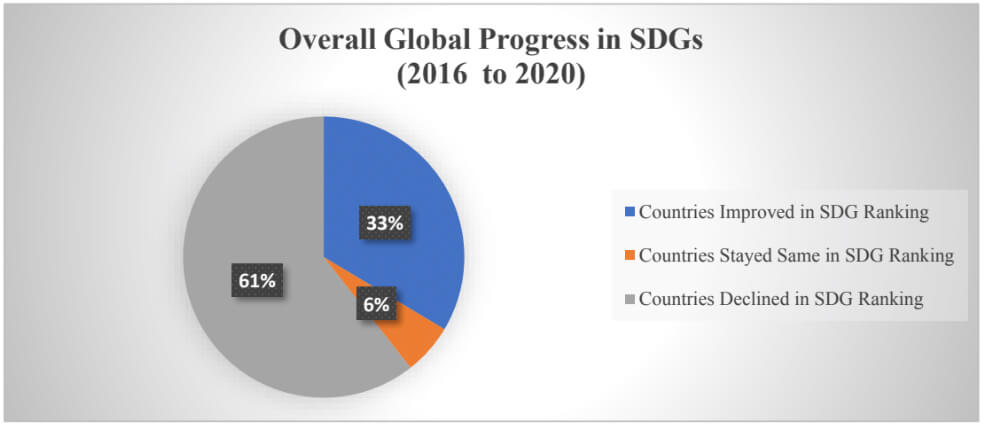
The protection of biodiversity, particularly in relation toGoal-14: Life Below Water, sustainable consumption and production, sustainable agriculture, and obesity are the areas of most concern for the high-income countries. Over the years, income equalities, such as the gender pay gap, are also becoming growing challenges among most high-income countries; while for low-income countries ending poverty, access to basic services and infrastructure are the most challenging agendas. However, low-income countries made considerable progress in the area of ending extreme poverty and in providing access to basic services and infrastructure, particularly underSDG-3: Good Health and Well-BeingandSDG-8: Decent Work and Economic Growth. At the same time, low-income countries tend to have lower SDG Index scores because of the nature of the SDGs they are addressing such as extreme poverty and providing access to basic services and infrastructure.
Among the countries, the Côte d’Ivoire, Burkina Faso, and Cambodia have progressed most in terms of the SDG Index score, while Venezuela, Zimbabwe, and the Republic of the Congo have declined the most in the SDG index score over the time period.
Other than Sweden and Denmark, very few countries have been able to maintain their SDG ranking between 2016 and 2020. Some of the other countries who were able to maintain their ranking include Austria, Ireland, Malta, Albania, Morocco, and few others.
Overall assessment in the Sustainable Development Report 2020 shows Low-income countries are on track or performing moderately well in only two SDGs: SDG-13 Climate Change Action and SDG-8 Decent Work and Economic Growth.
Lower-middle-income countries are on track or performing moderately in eight SDGs: SDG-13 Climate Change Action; SDG-1: No Poverty; SDG-2: Zero Hunger; SDG-3: Good Health and Well-Being; SDG-6 : lean Water and Sanitation; SDG-7: Affordable and Clean Energy; SDG-9: Industry, Innovation, and Infrastructure.
Upper-middle-income countries are either on track or performing moderately well in most of the areasexceptSDG-14: Life Below Water; SDG-15: Life on Land; and SDG-17 Partnership for the Goals.
High-income countries mostly performed positively in most of the SDGs except in two areas where performance are stagnating: SDG-13 Climate Change Action; and SDG-14: Life Below Water.
Region-wise analysis of data showedSDG-10: Reduced Inequalities; andSDG-11 Sustainable Cities and Communities are the two most concerning agendas, and these two areas are categorized as the “Major challenges remain” or “Significant challenges remain” or “Challenges remain” agenda.
Table-1a
2020 SDG trends of countries by Income Groups

Table-1a
2020 SDG trends of countries by Income Groups

In regard to government strategies and policy actions for climate mitigation, the Sustainable Development Report (2020) highlights that only six countries (Bhutan, Costa Rica, Ethiopia, India, Kenya, and the Philippines) have made sufficient commitment and effort to hold global warming well below 2°C. Unfortunately, economically stronger, or bigger countries such as the United States, the Russian Federation, Saudi Arabia, Turkey, Ukraine, and Vietnam are categorized as “critically insufficient” for their low level of commitment to mitigating climate change.
Region-wise SDG Ranking
Europe
In general, European countries are the best performers in the SDG rankings, compared with the rest of the world. In 2020, 46% of all European countries were able to improve in their respective SDG ranking, compared with the 2016 SDG ranking index. In 2020, Sweden, Denmark, Finland, Germany, and Norway are the five top SDG ranking countries in the region as well as in the rest of the world.
Table-2 Comparative SDG Ranking of European Countries

Figure-2

Although Europe as a region has performed better than the rest of the world, there remain are wide disparities in equity across European countries and across population groups.
The Leave No One Behind (LNOB) Index, which measures inequalities within countries, showed Eastern and Central Europe face significant challenges in terms of material deprivation, access to care, quality education, greater poverty, and lack of infrastructure including broadband internet connection.
Persistent high internal inequalities in many European countries are also impacting their overall SDG rankings. Overall, assessment shows goals related to responsible consumption and production, action against climate change, and biodiversity loss are most concerning and the trajectories in these indicators show the actions being undertaken to achieve these goals by 2030 are largely insufficient.
North & South America
Among North & South American countries, Canada, Chile, United States, Costa Rica and Uruguay are the overall top five SDG high ranking countries. At the same time, Venezuela, Argentina and Brazil are the only three countries in the region that have shown no progress in comprehensive attainment of the 17 SDGs since 2016. Venezuela is the only country which is losing its SDG index score because of its declining performance on SDG-1 No poverty, SDG-2 Zero hunger, and SDG-3 Good health and well-being.
On the other side, Argentina and Brazil have shown no progress in the last five years due to declining trends on SDG-8: Decent work and economic growth, and SDG 16 Peace, justice and strong institutions respectively.
Table-3 Comparative SDG Rankings of North & South American Countries

Among all the North & South American countries, only 43% of countries in the region have been able to improve in their SDG ranking in 2020, compared with their 2016 SDG ranking.
In the South American region, the lack of innovation due to relatively low public expenditure on R & D, high income inequalities, insecurity, high homicide rate, and corruption are the biggest challenges.
Figure-3

Figure-3
Among African countries, only 12% of all countries have been able to improve their SDG ranking in 2020, compared with their respective 2016 position.
In the African region, Tunisia, Morocco, Egypt, Cabo Verde and Ghana are the top five better performing countries in the SDG index score. In general, the North African countries are the better-performing countries, while the Central African countries are lagging the furthest behind in the region.
SDG-3 Good health and wellbeing, SDG-9 Infrastructure, and SDG-16 Peace, justice and strong institutions are the most critical areas for the continent. However, the continent is performing relatively better in SDG-13 Climate action, and SDG -12 Responsible consumption and production. The most important fact from the African continent is that 94% of the countries have eighter shown the significant requisite commitment to set-up institutional arrangements for successful implementation of the SDGs or aligned their national development plans with the SDGs.
Table-4 Comparative SDG Ranking of African Countries

Figure-4
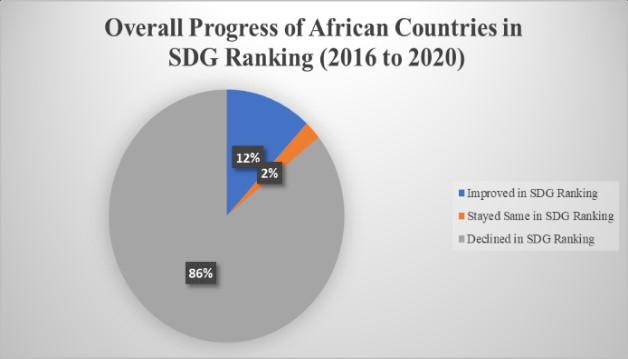
Asia & Oceania
In the Asia & Oceania region New Zealand, Japan, South Korea, Cyprus, and Australia are the top five better ranking countries in 2020. In this region, 39% of all countries have been able to improve their respective SDG ranking in 2020 compared with their 2016 overall ranking.
The region has made reasonable progress on SDG targets relating to economic growth, SDG-4:Quality Education, along with food security, women’s role in decision making, access to basic sanitation services, reduction in maternal mortality, child mortality, R&D for health. Some elements of progress also made in SDG-7:Affordable and clean energy.
Over the years the region has made considerable progress in SDG-1:No Poverty, SDG-2:Zero hunger, SDG-3:Good health and well-being, SDG-5:Gender equality, SDG-6: Clean water and sanitation, SDG-8:Decent work and economic growth, SDG-15: Life on land, SDG-16:Peace, justice and strong institutions, and SDG-17:Partnership for the goals.
At the same time, the region faces many others challenges and reverse trends in targets such as their share of renewable energy, climate change policies, loss of biodiversity, sustainable / inclusive industrialization, human trafficking, and non-discriminatory laws. Within the region there have been varying degrees of progress. For example: North and Central Asia have progressed in reducing inequalities (SDG-10); whereas South-East Asia has regressed in SDG-10. Southwest Asia has made the most progress in SDG-3: Good health and Well-being. Southeast Asia progressed most in SDG-4: Quality Education, and SDG-9 Industry, innovation and infrastructure. East and Northeast Asia have improved in SDG-2: Zero hunger, SDG-4: Quality Education, and SDG-6: Clean water and sanitation.
Table-5 Comparative SDG Ranking of
Asian Countries
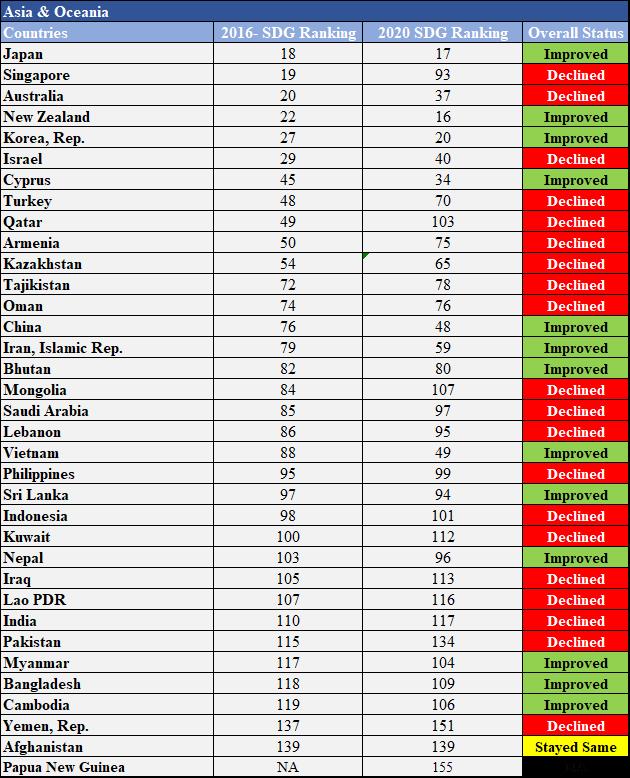
Figure-5

SAARC Region
Within the Asia & Oceania region, South Asia is one of the most populated regions. It is home for about 22% of the world’s population (which is a population of about 1.76 billion, as of 2016’s data).
The region has one of the largest concentrations of the under-privileged population, with acute caste system issues, a high number of dowry deaths and honour killing issues, farmers’ suicides.
Table-6 Comparative SDG
Ranking of SAARC Countries

water and sanitation problems, environmental degradation and server pressures for wild-life and biodiversity. Within the SAARC region, Bhutan, Maldives, Sri Lanka, Nepal and Bangladesh are the better performing countries as well as improving their respective ranking.
Australia
Australia is among the high-income OECD countries. Compares with its 2016 SDG ranking Australia has dropped position from 20th overall ranking to 37th position. According to the Sustainable Development Report 2020 Australia is in the “On Track” or “SDG achieved” category in only in SDG-3 (Good Health and Well-being). In other SDGs, such as SDG-5: Gender Equality and SDG-8: Decent work and Economic growth Australia is in the “On Track” category, however, the agendas are categorized as “Significant challenges remain”.
In the following SDGs, such as: SDG-10: Reduce Inequalities, SDG-11: Sustainable Cities and Communities, SDG-13: Climate Action, SDG-14: Life Below Water, SDG-15: Life on Land, and SDG-17: Partnerships for the goal, the country’s indicators are classified as “stagnant”, with varying degrees of challenges ranging from significant to major. SDG-12: Responsible consumption and production remain one of the major challenging areas for Australia.
In the rest of the SDG indicators the country has achieved a moderate level of improvement with varying degrees of challenges.
Conclusion
The overall region-wise analysis showed that from 2010 onwards countries in East and South Asia have progressed the most and a similar trend has been noticed since implementation of the SDGs in 2015. African countries made significant improvements during the MDG period (2000 – 2015) but since 2015 these countries have made some progress in SDGs. Furthermore, on average, countries; in Latin America, Caribbean, Eastern Europe, Central Asia, Middle East, and in North African regions, have increased their SDG index score by more than one point.
At the same time, income-wise analysis shows that high-income countries may have the highest SDG index score but progressed moderately in SDGs since 2015, while Low and Middle-income countries progressed faster in SDGs compared with high-income countries.
The SDG trend analysis highlights indicators relating to SDG-1: No Poverty, SDG-9: Industry, Innovation, and Infrastructure, and SDG-11: Sustainable Cities and Communities have made the most rapid progress since 2015. Globally, access to basic transport infrastructure, broadband connection, and global investment in R&D have shown the most promising trends. At present, about 95% of the world’s population is covered by 3G or higher-quality mobile networks, which is one of the most significant universal achievements.
In conclusion, I would like to highlight that even though progress in SDGs between 2016 to 2020 shows mixed success, the impact of Covid-19 may have wiped out gains in the areas of poverty reduction, employment, health and reducing income inequality. Only future data will demonstrate the extent of such losses.
Sources: 2016 & 2020 Online Database for Sustainable Development Report; Sustainable Development Report 2020
The Global Sustainable Development Goals: Are we progressing?
Author: Dr Kuntal Goswami, ACSDRI
Key words: Progress on Sustainable Development Goals, Sustainable Development Goals.
Citation: Goswami, K (2021), ‘The Global Sustainable Development Goals: Are we progressing?’, The Blue Planet – A Magazine on Sustainability, Australian Centre of Sustainable Development Research & Innovation (ACSDRI), Australia, Issue 3 Vol-1, pp. 12-23. ISSN : 2652-7987 https://acsdri.com/publications-on-sustainable-development/sustainable-development-goals-are-we-progressing/
Progress on Sustainable Development Goals
In 2015 all United Nations member states adopted the global Sustainable Development Goals(SDGs). In contrast with the Millennium Development Goals (MDGs), which were developing countries centric and had 60 indicators, SDGs are universal and address issues for both developed and developing countries. The SDGs are all-encompassing, with 17 goals and 169 associated targets addressing global objectives for economic development, social inclusiveness, and environmental sustainability.
This brief status report compared 2016 and 2020 SDG data sets to understand the global progress towards the Sustainable Development Goals. Compared with the 2016 global SDG ranking index, only 33% of all countries could improve their respective SDG ranking in 2020; 6% could maintain their status quo, while 61% of all countries declined in their overall SDG ranking.
In the “Countries Improved in SDG ranking” category, Europe has 18 countries, followed by the Asia and Oceania region with 13 countries. Among the North and South American countries, only ten were able to improve their overall ranking. Only five countries in the African region featured in this category. Most of the “Countries declined in SDG ranking” category are from the African region, followed by the Asia and Oceania region, the European region, and the North and South America region.
In 2016 and 2020, Sweden and Denmark ranked at the top in the overall SDG ranking.
Figure-1 Overall Global Progress in SDGs between 2016-2020
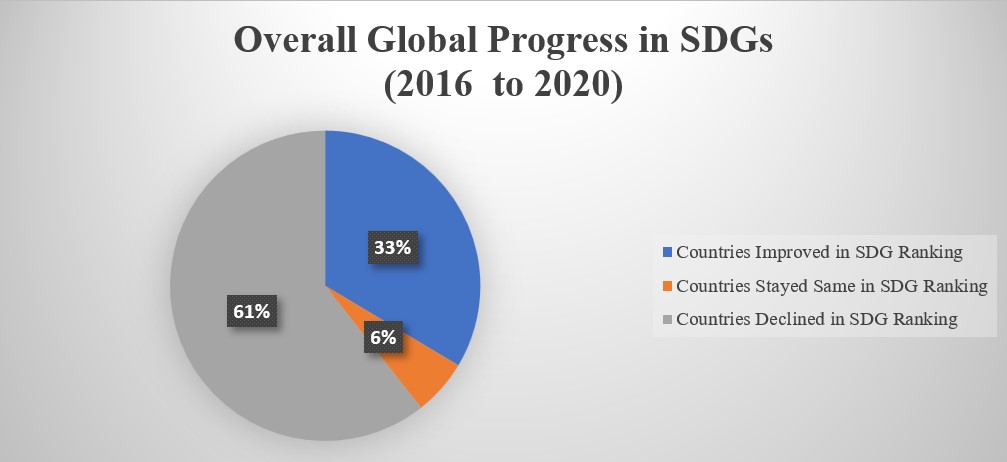
Progress of Specific Sustainable Development Goals between 2016-2020
The protection of biodiversity (particularly concerning Goal-14: Life Below Water), sustainable consumption and production, sustainable agriculture, and obesity are the most concerning areas for high-income countries. Over the years, income equality, such as the gender pay gap, has become a growing challenge among most high-income countries. Ending poverty and access to essential services and infrastructure are the most challenging agendas for low-income countries. However, low-income countries made considerable progress in ending extreme poverty and providing access to essential services and infrastructure, particularly under SDG-3: Good Health and Wellbeing and SDG-8: Decent Work and Economic Growth. At the same time, low-income countries tend to have lower SDG Index scores because of the categories of SDG targets they are addressing, such as extreme poverty and providing access to essential services and infrastructure.
Country-specific SDG progress between 2016-2020
Among the countries, Côte d’Ivoire, Burkina Faso, and Cambodia have progressed the most in terms of the SDG Index score. At the same time, Venezuela, Zimbabwe, and the Republic of the Congo have declined the most in the SDG index score over the same period. Other than Sweden and Denmark, very few countries have been able to maintain their SDG ranking between 2016 and 2020. Some of the other countries that were able to maintain their ranking include Austria, Ireland, Malta, Albania, Morocco, and a few others.
The overall assessment of the 2020 Sustainable Development Report shows that low-income countries are on track or performing moderately well in only two SDGs: SDG-13 Climate Change Action and SDG-8 Decent Work and Economic Growth.
Lower-middle-income countries are on track or performing moderately in eight SDGs: SDG-13 Climate Change Action; SDG-1: No Poverty; SDG-2: Zero Hunger; SDG-3: Good Health and Wellbeing; SDG-6: Lean Water and Sanitation; SDG-7: Affordable and Clean Energy; SDG-9: Industry, Innovation, and Infrastructure.
Upper-middle-income countries are either on track or performing moderately well in most areas except SDG-14: Life Below Water, SDG-15: Life on Land, and SDG-17 Partnership for the Goals.
High-income countries mostly performed positively in most SDGs except in two areas where performance stagnated: SDG-13 Climate Change Action and SDG-14: Life Below Water.
Region-wise analysis of data showed SDG-10: Reduced Inequalities and SDG-11 Sustainable Cities and Communities are the two most concerning agendas, and these two areas are categorized as the “Major challenges remain” or “Significant challenges remain” or “Challenges remain” agenda.
Table-1a SDG trends in 2020 of countries by Income Groups

Table-1b SDG trends in 2020 of countries by Income Groups

In regard to government strategies and policy actions for climate mitigation, the Sustainable Development Report (2020) highlights that only six countries (Bhutan, Costa Rica, Ethiopia, India, Kenya, and the Philippines) have made sufficient commitment and effort to hold global warming well below 2°C. Unfortunately, economically stronger or bigger countries such as the United States, the Russian Federation, Saudi Arabia, Turkey, Ukraine, and Vietnam are categorized as “critically insufficient” for their low commitment to mitigating climate change.
Region-wise SDG Ranking between 2016-2020
Progress on Sustainable Development Goals in Europe between
2016-2020
In general, European countries are the best performers in the SDG rankings compared with the rest of the world. In 2020, 46% of all European countries were able to improve their respective SDG ranking, compared with the 2016 SDG ranking index. In 2020, Sweden, Denmark, Finland, Germany, and Norway were the five top SDG-ranking countries in the region and the rest of the world.
Table 2 Comparative SDG Ranking of European Countries

Figure-2 Overall Progress of European Countries in SDG Ranking (2016-2020)
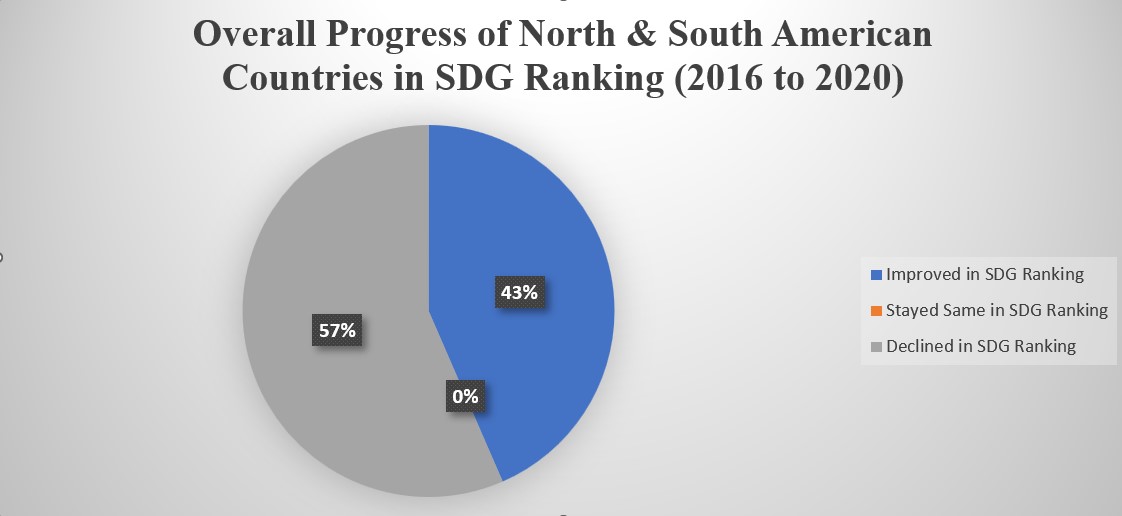
Although Europe has performed better than the rest of the world, there remain wide disparities in equity across European countries and population groups. The Leave No One Behind (LNOB) Index, which measures inequalities within countries, shows Eastern and Central Europe faces significant challenges in terms of material deprivation, access to care, quality education, greater poverty, and lack of infrastructure, including broadband internet connection.
Persistent high internal inequalities in many European countries also impact their overall SDG rankings. Overall, the assessment shows that goals related to responsible consumption and production, action against climate change, and biodiversity loss are most concerning, and the trajectories in these indicators show that the actions undertaken to achieve these goals by 2030 are largely insufficient.
Progress on Sustainable Development Goals among North and South American countries between 2016-2020
Among North and South American countries, Canada, Chile, the United States, Costa Rica, and Uruguay are the top five SDG high-ranking countries in the overall ranking. At the same time, Venezuela, Argentina, and Brazil are the only countries in the region that have yet to show progress in the comprehensive attainment of the 17 SDGs since 2016. Venezuela is the only country losing its SDG index score because of its declining performance on SDG-1 No Poverty, SDG-2 Zero Hunger, and SDG-3, Good Health and Wellbeing. Conversely, Argentina and Brazil have not shown progress in the last five years due to declining trends on SDG-8, decent work and economic growth, and SDG 16: Peace, justice, and strong institutions, respectively.
Table 3 Comparative SDG Rankings of North & South American Countries
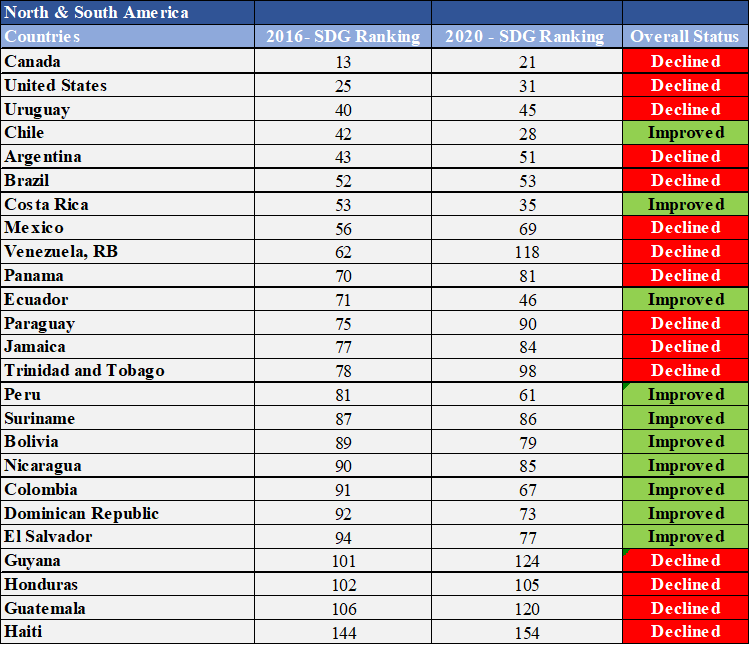
Among all the North and South American countries, only 43% of countries in the region have been able to improve their SDG ranking in 2020 compared with their 2016 SDG ranking. In the South American region, the lack of innovation due to relatively low public expenditure on R & D, high-income inequalities, insecurity, high homicide rate, and corruption are the biggest challenges.
Figure-3 Overall Progress of North & South American Countries in SDG Ranking (2016 to 2020)
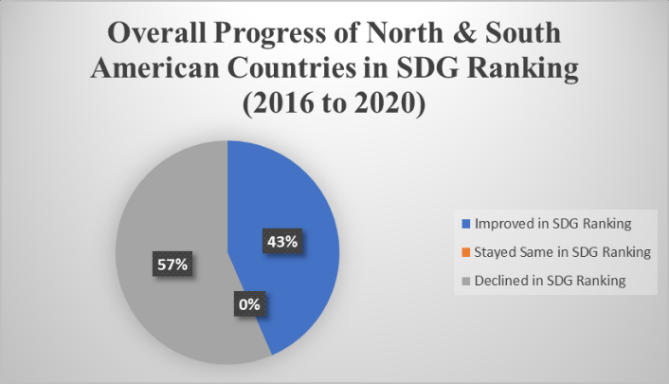
Progress of Sustainable Development Goals among African countries between 2016-2020
Among African countries, only 12% have been able to improve their SDG ranking in 2020 compared with their respective 2016 position. Africa, Tunisia, Morocco, Egypt, Cabo Verde, and Ghana are the top five best-performing countries in the SDG index score. The North African countries are generally the better-performing countries, while the Central African countries lag the furthest behind in the region.
SDG-3 Good Health and Wellbeing, SDG-9 Infrastructure, and SDG-16 Peace, justice, and strong institutions are the most critical areas for the continent. However, the continent performs relatively better in SDG-13 Climate Action and SDG-12 Responsible Consumption and Production. The most important fact from the African continent is that 94% of the countries have either shown the significant requisite commitment to set up institutional arrangements for successful implementation of the SDGs or aligned their national development plans with the SDGs.
Table 4 Comparative SDG Ranking of African Countries
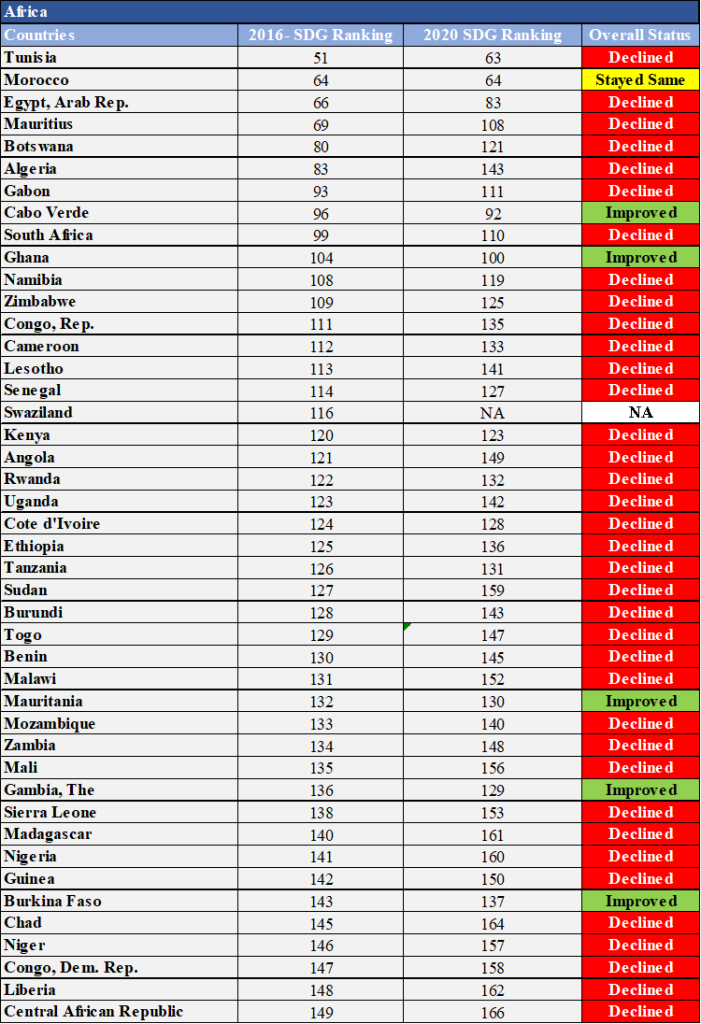
Figure-4 Overall Progress of African Countries in SDG Ranking (2016-2020)

Progress of among Asia & Oceania countries between 2016-2020
Among Asia and Oceania countries, New Zealand, Japan, South Korea, Cyprus, and Australia were the top five better-ranking countries in 2020. In this region, 39% of all countries have improved their respective SDG ranking in 2020 compared with their 2016 overall ranking. The region has made reasonable progress on SDG targets relating to economic growth, quality education, food security, women’s role in decision-making, access to essential sanitation services, reduction in maternal mortality, child mortality, R&D for health. Some elements of progress were also made in SDG-7: affordable and clean energy. Over the years the region has made considerable progress in SDG-1: No Poverty, SDG-2: Zero hunger, SDG-3: Good health and wellbeing, SDG-5: Gender equality, SDG-6: Clean water and sanitation, SDG-8: Decent work and economic growth, SDG-15: Life on land, SDG-16: Peace, justice and strong institutions, and SDG-17: Partnership for the goals.
At the same time, the region faces many challenges and reverse trends in targets, such as their share of renewable energy, climate change policies, loss of biodiversity, sustainable/inclusive industrialization, human trafficking, and non-discriminatory laws. Within the region, there have been varying degrees of progress. For example, North and Central Asia have progressed in reducing inequalities (SDG-10), whereas South-East Asia has regressed in SDG-10. South West Asia has made the most progress in SDG-3: Good health and Wellbeing. South East Asia progressed most in SDG-4: Quality Education, SDG-9 Industry, innovation, and infrastructure. East and Northeast Asia have improved in SDG-2: Zero Hunger, SDG-4: Quality Education, and SDG-6: Clean water and sanitation.
Table 5 Comparative SDG Ranking of Asian Countries
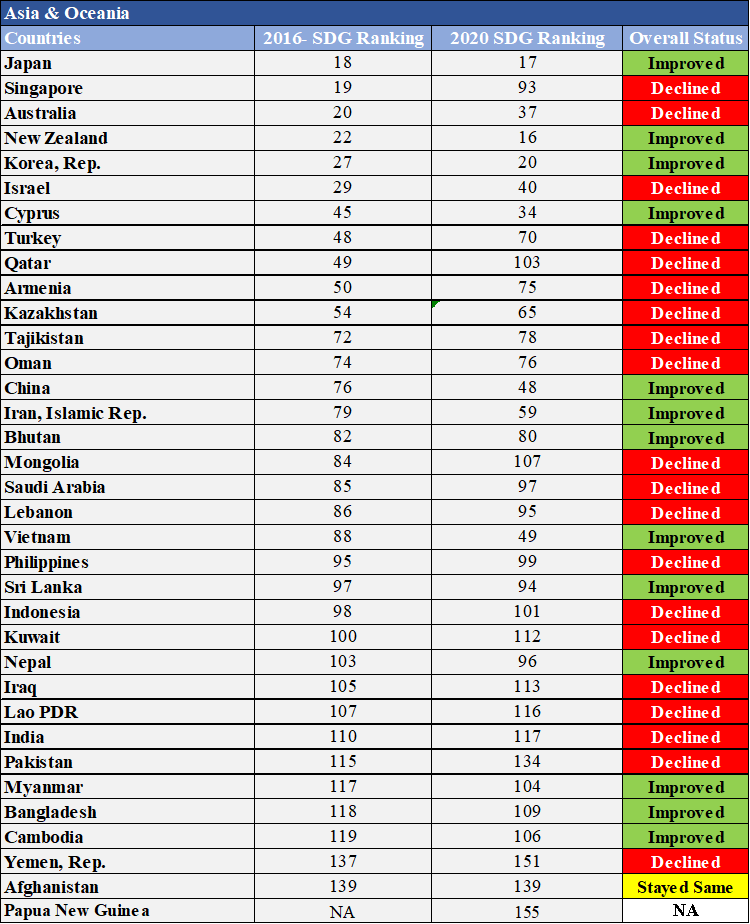
Figure-5 Overall Progress of Asian & Oceanian Countries in SDG Ranking (2016-2020)
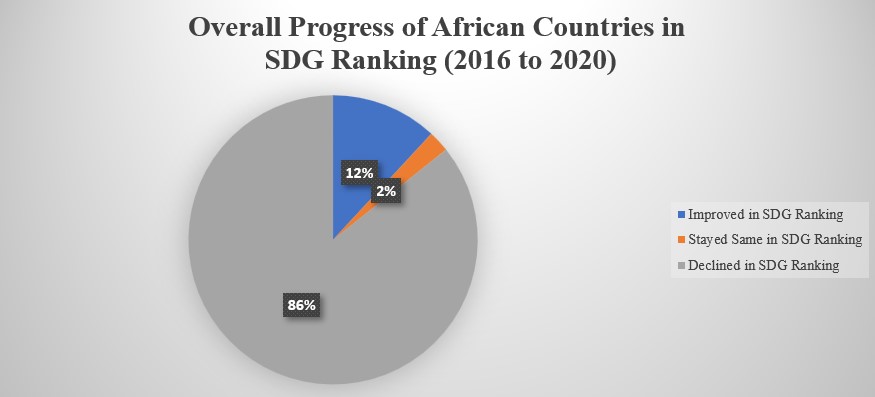
Progress of Sustainable Development Goals among SAARC Region between 2016-2020
South Asia is one of the most populated regions within Asia and Oceania. It is home to about 22% of the world’s population (about 1.76 billion, as of 2016’s data).
Table 6 Comparative SDG Ranking of SAARC Countries

The region has one of the largest concentrations of the underprivileged population, with acute caste system issues, many dowry deaths and honor killings, farmers’ suicides, water and sanitation problems, environmental degradation, and severe pressures on wildlife and biodiversity. Within the SAARC region, Bhutan, Maldives, Sri Lanka, Nepal, and Bangladesh are the better-performing countries, improving their ranking.
Progress of Sustainable Development Goals in Australia between 2016-2020
Australia is among the high-income OECD countries. Compared with its 2016 SDG ranking, Australia has dropped from 20th overall ranking to 37th. According to the Sustainable Development Report 2020, Australia is in the “On Track” or “SDG achieved” category only in SDG-3 (Good Health and Wellbeing). In other SDGs, such as SDG-5: Gender Equality and SDG-8: Decent Work and Economic Growth, Australia is in the “On Track” category. However, the agendas are categorized as “Significant challenges remain.”
The following SDGs, such as SDG-10: Reduce Inequalities, SDG-11: Sustainable Cities and Communities, SDG-13: Climate Action, SDG-14: Life Below Water, SDG-15: Life on Land, and SDG-17: Partnerships for the goal, the country’s indicators are classified as “stagnant”, with varying degrees of challenges ranging from significant to primary. SDG-12: Responsible consumption and production remain two major challenges for Australia. In the rest of the SDG indicators, the country has achieved a moderate level of improvement with varying degrees of challenges.
Conclusion
The overall region-wise analysis showed that from 2010 onwards, countries in East and South Asia have progressed the most, and a similar trend has been noticed since the implementation of the SDGs in 2015. African countries made significant improvements during the MDG period (2000 – 2015), but since 2015, these countries have made some progress in SDGs. Furthermore, on average, countries in Latin America, the Caribbean, Eastern Europe, Central Asia, the Middle East, and North Africa have increased their SDG index score by more than one point.
At the same time, income-wise analysis shows that high-income countries may have the highest SDG index score but have progressed moderately in SDGs since 2015, while low- and middle-income countries have progressed faster in SDGs than high-income countries.
The SDG trend analysis highlights indicators relating to SDG-1: No Poverty, SDG-9: Industry, Innovation, and Infrastructure, and SDG-11: Sustainable Cities and Communities have made the most rapid progress since 2015. Globally, access to primary transport infrastructure, broadband connection, and global investment in R&D have shown the most promising trends. About 95% of the world’s population in 2020 is covered by 3G or higher-quality mobile networks, one of the most significant universal achievements.
In conclusion, even though progress in SDGs between 2016 and 2020 shows mixed success, the impact of COVID-19 may have wiped out gains in poverty reduction, employment, health, and income inequality. Only future data will demonstrate the extent of such losses.

